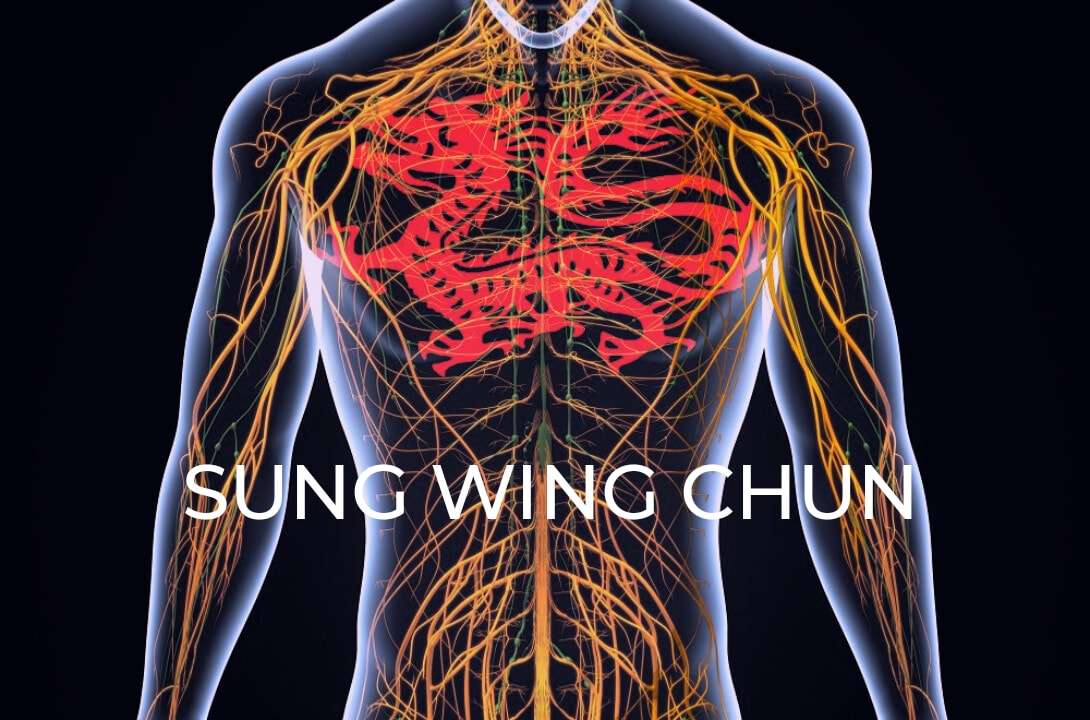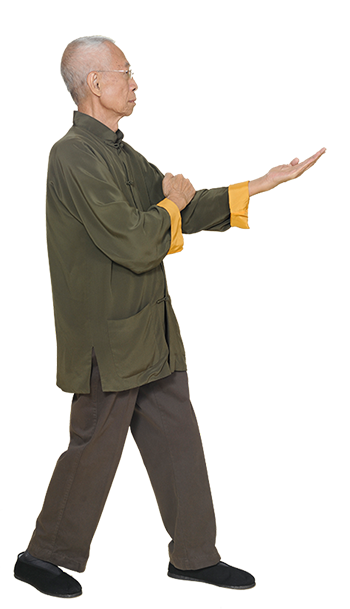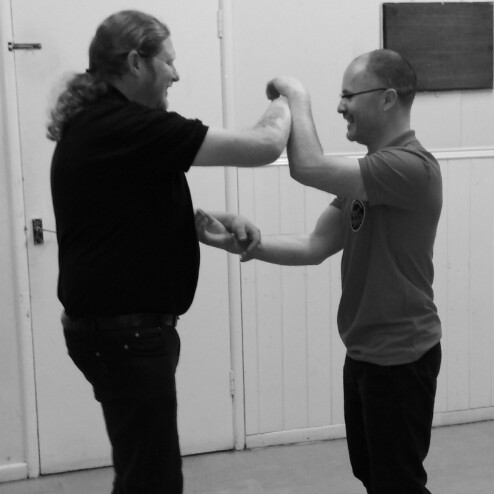|
Less than two weeks ago we took on a big experiment at Sung by progressing over a dozen students to learn the chum kui form. Wing chun is a traditional Chinese martial arts without a ranking system, so historically students are moved on individually when they are deemed to have met some arbitrary criteria. We have decided to follow a method introduced by Chu Shong Tin which he used a few years before he died; knowing he was ill he chose to teach the entire system to his regular students over a three year period so he could ensure he had passed on the same knowledge to them all (even though some had completed the system decades earlier). Some of our students are ready to move on, some almost, and one or two are just taking it as a learning experience. I am not saying we will teach the whole system in three years (CST was able to teach 5 nights a week) but we do want diligent students to learn the system in a reasonable time so they can get a full picture on how it works. These are my observations and tips so far: 1. Chum kui (CK) is an extension of Sil Lim Tao (SLT), in fact it is SLT with stepping and body rotation. 2. For the ideas of CK to work effectively you need to relax, settle on yourself, release into your elbow and rest on your opponent before you even start to move. 3. When you pivot you should release your spine, soften your lower back and hips and rotate over the tips of the thigh bones. The movement is a release. 4. Do not push the hip and shoulder behind the movement; that will provide a direct alignment into your structure for the opponent to feel and manipulate. 5. Do not twist your spine. 6. Release the knees, soften the ankles. 7. Acknowledge that just because at least one extra rotation is happening, you cannot and should not try to control how that rotation will effect each of your joints (that will again only lead to crude alignment). Done properly the opponent will first feel the effect of lifting you (because you are maintaining a release into your elbow) and the extra rotations will be difficult for them to counter. 8. If it feels powerful you are probably doing it wrong. You are only feeling the feedback of tensed muscles. If it feels relatively effortless, you are on the right track. 9. A great observation from Mark; most people translate Chum Kui as ‘seeking the bridge’, Mark’s translation was investigating the bridge. For me the idea of seeking means you are looking (chasing)for the opponent’s hand (wrong – in fighting we want to hit the body or face not limbs). The term investigating implies the form is about working out how to deal with someone whilst you already have contact. 10. Practice pivoting every day, learn not to lean back and maintain you centre of gravity above your hips (use a mirror). 11. Do it slowly at first. Doing it quicky is a cheat's method to hide inadequacy. The plan is to work on the first part of the form until Autumn, those who are ready can then move on to the second part of the form once the basics are in place. The second part involves more movement and crucially kicking. It will take quite a bit of work to reach a level where the movements of the leg infuse the same ideas as the movements of the arms we have taught, so that will be an exciting time. If we complete the whole form in the New Year those who have kept up the work start the Bil Gee around this time next year.
3 Comments
Although we are only a small club at Sung, we have a far reach in respect of our students. Our most distant student is Rini Pijneburg from The Netherlands who travels to us twice yearly. Below is an account of his experience so far with us.
On the 2nd of June I ended my third, 10 days to 2 weeks, training at Sung Wing Chun in Sheffield within a years time. Earlier in my life I had trained Wing Chun for about 14 years in the Wang Kiu lineage and later on for a year and a half in the Wong Shun Leung lineage, all in The Netherlands. I had in both instances stopped the formal training due to the fact that I was too tense and didn't manage to do anything about it. I sort of gave up on it. But somehow Wing Chun never gave up on me. It always kept coming back to me. I always kept coming back to doing the three hand forms at home, on my own. During the Wang Kiu years a grandmaster seminar had been organized that besides Wang Kiu and Wong Shun Leung also featured Chu Shong Tin. I was impressed by the latter. Years later, early 2015 I did some research on the internet on Chu Shong Tin lineage Wing Chun. I found out that Sung Wing Chun had started half a year earlier and that they were teaching Chu Shong Tin Wing Chun in Sheffield. In total I have now spent 39 days in Sheffield. Most important for me is that my problem, being tense, is a central subject in the way Wing Chun is being taught. Being 'Sung' (relaxed with purpose) is essential and is a core theme of the teachings. Being Sung while being under stress because of the force your opponent puts on you is what I am learning through 'Standing Practice', Wing Chun's first form Siu Lim Tao and single and double hand Chi Sau. Standing Practice is about relaxing your muscles while standing, about learning to let go your muscles on a conscious and a sub-conscious level, about 'opening' joints and about learning to deal with ones own mass. Siu Lim Tao and Chi Sau are standard elements of Wing Chun training. The way Wing Chun is being taught in class differs from my earlier experiences in that a lot of the teacher's attention goes on the Wing Chun body structure and helping students to 'letting go' their muscles and to learn to put ones mass on the opponent. While students individually do Standing Practise or a form, teachers correct stanches and help with 'letting go'. Forms are taught group wise; movements are being copied and the intension of the different moves are discussed. Students are encouraged to test their skills in partner exercises and in Chi Sau training. In doing partner exercises and Chi Sau with the teachers, students are taught a better understanding of what 'letting go' means. (Luckily there 3 teachers.) There is no sparring at this stage. Mark, Daniel and Jonathan are three excellent teachers who together 'run' Sung Wing Chun. They themselves are well trained, travelled to Hong Kong for 7 years to train at Chu Shong Tin's kwoon and are still actively training amongst themselves to upgrade the level of their skills. Besides that they are kind and do their utmost in supporting their students. I always feel very welcome and enormously supported when attending the classes and private lessons. Besides the lessons they provide me with applicable guidance at how to develop my abilities while being at home in The Netherlands in between my time in Sheffield. While being in Sheffield I use to stay at the Buddhist Centre on Ecclesall Road which is within walking distance of the training facilities and a nice and affordable place to stay. Relaxed Power
6/1/2016
There are a lot of terms currently being used in wing chun to define some sort of mythical force it is able to generate. One of the oldest terms is gung lik, the newest is force flow and there are others such as fa jing, chi and nim lik (Chu Shong Tin's term). In order to be polite I will label the majority of these as marketing. You are either using pushing and pulling (muscular contraction) or you are using what we at Sung call relaxed power.
Relaxed power feels different. It is smothering and multidirectional; annoying uncomfortable. You can only cultivate it to a useful level if you practice it purposefully. Some may get it by chance after many years of training, but most others just get more tense and eventually injuries lead them to giving up. A lot of people do think they have it, they show how loose their muscles are in their arms when at rest, but in order to create any force they lock their shoulders and tense up at the last moment of the hit. Sorry, but it you tense up on contact (even when you punch) then that is not relaxed; you are kidding yourself. If you do not believe me when I say you should not tense on contact, then there is a whole new world of relaxation you can work on. This is not a dig at using muscular force, it is a tremendously powerful method and the basis of most arts. I won't say relaxed power is better, just a better fit for those who do not have much mass and want to avoid injury (time lost on injuries is a major reason people give up training). It is body mass which is the key, as relaxed power is about making your opponent deal with that mass on first contact. Learn how to use that initially at a slow pace, then add acceleration to make it applicable in a fight. I would estimate that only about 10% of wing chun practitioners have any idea about relaxed power. You will not find the secret on youtube, FB or down the back of the sofa. You have to feel it to get a grasp of it. Another problem can lead from it in that those who do have it go one step further and start claiming they have internal powers, but again it is probably only 10% of those who have that either. What is internal power? Now that is a good question I will leave those who are best qualified... Note - the term Relaxed Power (c) is now copyrighted and trade marked to Sung Wing Chun. Anyone who dares to use it from now on risks me blocking them on Facebook and all social media until they say they are sorry. |
AuthorKeeping you up to date with what is happening in class Archives
July 2024
Categories |




 RSS Feed
RSS Feed